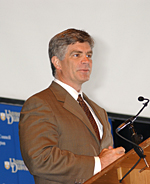
The agreements are the American College and University Presidents Climate Commitment, a high-visibility effort to address global warming, and The Talloires Declaration by the Association of University Leaders for a Sustainable Future, a 10-point action plan by universities worldwide.
Harker, who described UD's participation in the agreements as “another significant step in our effort to become a more sustainable University,” announced the signings at the start of Wednesday evening's Global Agenda lecture in Mitchell Hall. The lecture series this year has focused on the topic, “Boiling Point: International Politics of Climate Change.”
“This series is certainly a most appropriate place--and Earth Week a most appropriate time--to break the news,” Harker said.
The Talloires Declaration has been signed by more than 350 university presidents and chancellors in 40 countries. By joining them, the University pledges to integrate sustainability into its operations, to produce research and scholarship critical in supporting continued environmental progress across the globe and to engage the campus, community, the state and the world in the effort.
Signers of the Talloires Declaration express their concern about “the unprecedented scale and speed of environmental pollution and degradation and the depletion of natural resources.” The declaration cites such environmental threats as air and water pollution, toxic waste, deforestation, the depletion of the Earth's ozone layer and the emission of greenhouse gases.
Universities play a key role in such areas as education, research, policy development and the exchange of information that can address these environmental concerns, the declaration says.
Signers agree to take 10 actions:
- Increase awareness of environmentally sustainable development;
- Create an institutional culture of sustainability;
- Educate for environmentally responsible citizenship;
- Foster environmental literacy for all students;
- Practice institutional ecology, setting an example for others;
- Involve all stakeholders in research, education and other efforts;
- Collaborate to develop interdisciplinary approaches;
- Enhance the capacity of primary and secondary schools by establishing partnerships;
- Broaden service and outreach nationally and globally; and
- Maintain the momentum in continuing to carry out the declaration.
The second agreement, the American College and University Presidents Climate Commitment, recognizes the unique leadership role and obligation that institutions of higher education have in responding to the global climate crisis. UD joins 521 other institutions in a collective effort to reduce carbon emissions across the United States.
By signing onto the Commitment, the University pledges to begin the process of reducing its greenhouse gas emissions and becoming climate-neutral.
The document states that universities can be leaders in serving as “role models for their communities and in training the people who will develop the social, economic and technological solutions to reverse global warming.” In addition, the presidents and chancellors signing the commitment say they believe that taking action will stabilize or reduce their institution's energy costs, will attract excellent students and faculty, as well as new funding sources, and will increase the support of alumni and local communities.
Specifically, the Commitment calls for these actions:
- Completing an emissions inventory;
- Taking immediate steps to reduce greenhouse gas emissions;
- Within two years, setting a target date and interim milestones for becoming climate neutral;
- Integrating sustainability into the curriculum; and
- Making the action plan and reports available to the public.
“These are challenging times for the entire planet, and the signing of these two documents reflects our intention that this University must be an active and dynamic force in addressing these global issues,” Harker said.
He noted that UD has already launched some efforts, including the Carbon Footprint Initiative, supported by the 2008 Senior Class and led by John Byrne, director of the University's Center for Energy and Environmental Policy and recent Nobel Peace Prize laureate as a member of the Intergovernmental Panel on Climate Change. Announced earlier this month, the initiative will assess the University's greenhouse gas emissions and develop strategies to reduce them.
The University also has developed a new sustainability Web site, which can be found at [www.udel.edu/sustainability]. The site gathers together in one place many of the activities that are already under way on campus and provides information on current research that addresses these topics.
In addition, Harker made note of the recently completed report of the University's Strategic Planning Committee. That report, delivered to him last month, calls for UD to become a national and international resource for environmental research technology and policy and to “Become the Green University.”
For more information about the agreements, including the full text of each and a list of others signatories and supporters, see the Web sites [www.presidentsclimatecommitment.org] and [www.ulsf.org/talloires_declaration.html].
Article by Ann Manser
Photo by Duane Perry

